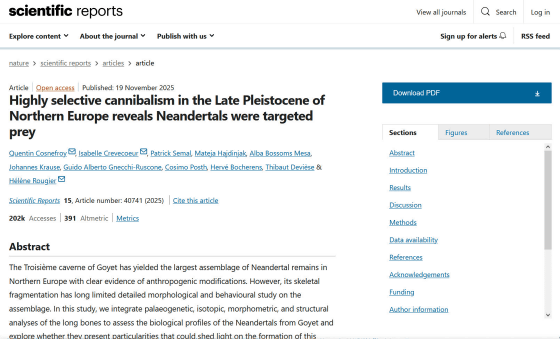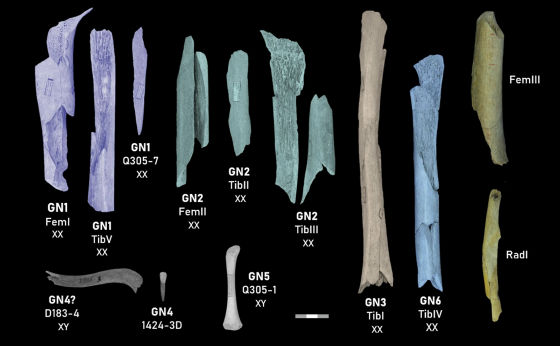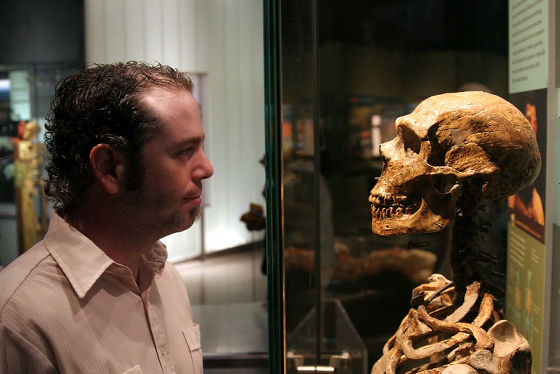Neanderthals may have cannibalized 'outsiders' women and children about 45,000 years ago

by
A new study published in the academic journal Scientific Reports suggests that Neanderthals may have engaged in cannibalism , eating ' uninhabited women and children,' despite being a species of human that first appeared on Earth about 400,000 years ago.
Highly selective cannibalism in the Late Pleistocene of Northern Europe reveals Neandertals were targeted prey | Scientific Reports
https://www.nature.com/articles/s41598-025-24460-3

Neanderthals cannibalized 'outsider' women and children 45,000 years ago at cave in Belgium | Live Science
https://www.livescience.com/archaeology/human-evolution/neanderthals-cannibalized-outsider-women-and-children-45-000-years-ago-at-cave-in-belgium
In the late 19th century, archaeologists exploring the Gohier Caves in Belgium discovered 101 Neanderthal bone fragments, dating back approximately 45,000 years. Many of the bones bore traces of butchered animals, suggesting that someone had eaten the Neanderthals.
A research team led by Quentin Cosnefroy, a postdoctoral researcher in archaeology at the University of Bordeaux in France, investigated the biological profile of bone fragments found in the Gohier Caves.
The research team reconstructed the dismembered bones as best they could and found that the fragmented bones belonged to at least six Neanderthals. Genetic analysis of the bones revealed that four of the six were adolescent females and two were males. The four females were unrelated and were shorter than the average Neanderthal female.
The image below shows Neanderthal bones excavated from the Gohier Cave, color-coded by individual. Bones identified as GN1, GN2, GN3, and GN6 are those of adolescent females, while bones identified as GN4 and GN5 are those of males.

Previous studies examining isotopes in bones from the Gohier cave system have shown that these Neanderthals lived in very different regions to where they died, but had similar diets.
Combining their findings with those of previous studies, the researchers argue that the Neanderthal bones found in the Gohier caves suggest that one group targeted other outgroups in a cannibalistic campaign. 'At the very least, this suggests that vulnerable members of one or more groups within a single, adjacent region were deliberately targeted,' they write.
'While the exact reason for these individuals' targeting is unknown, the group composition of four adult females and two children is unusual enough to be unlikely by chance,' Kosnefroy said in an email to Live Science.
It's possible that these Neanderthals were eaten by early Homo sapiens, who were also moving into the region at the same time. However, while cannibalism among early Homo sapiens is generally associated with funeral rituals, subsistence cannibalism has also been documented at Neanderthal sites in France and Croatia, so it's more likely that Neanderthals were the ones who ate the Gohier Cave Neanderthals.

by Young Sok Yun
The Neanderthals found in the Gohier caves were some of the last Neanderthals to survive in Europe at the time Homo sapiens began to move into the region. The researchers point out that the encounter between two previously isolated Neanderthal groups may have led to deadly tensions between them.
It's unclear how the cannibalized Neanderthals arrived at the Gohier caves, but most of the bones found there were leg bones. 'It's much easier to transport a living person than a corpse or body parts,' said Cosnefroy. 'It's possible they were transported alive, killed near the Gohier caves, and the cannibals left only selected parts in the cave.'
Related Posts:
in Free Member, Science, Posted by log1h_ik







